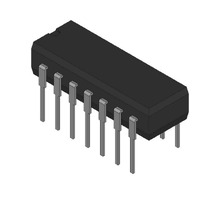Manufacturer Part Number
SN74S40N
Manufacturer
Texas Instruments
Introduction
The SN74S40N is a dual 4-input positive-NAND gate that provides high-speed, high-drive capability for a variety of digital logic applications. It features low propagation delay, high noise immunity, and can drive up to 10 standard TTL loads. This device is well-suited for use in high-speed digital systems, such as computers, industrial controls, and telecommunications equipment.
Product Features and Performance
Dual 4-input positive-NAND gate
High-speed operation with low propagation delay
High drive capability, can drive up to 10 standard TTL loads
High noise immunity
Operates from a single 5V power supply
Available in a standard 14-pin DIP package
Product Advantages
Provides high-speed, high-drive logic functions for digital systems
Offers improved noise immunity compared to standard TTL logic
Versatile device suitable for a wide range of digital logic applications
Key Reasons to Choose This Product
Proven reliability and performance from a trusted manufacturer
Optimized for high-speed, high-drive digital logic applications
Excellent noise immunity and signal integrity
Cost-effective solution for a variety of logic functions
Quality and Safety Features
Manufactured to strict quality standards
Undergoes rigorous testing and screening to ensure reliability
Complies with relevant safety and regulatory standards
Compatibility
The SN74S40N is compatible with standard TTL and CMOS logic families, making it suitable for use in a wide range of digital systems.
Application Areas
Computers and computer peripherals
Industrial control systems
Telecommunications equipment
Instrumentation and test equipment
Medical electronics
Any application requiring high-speed, high-drive digital logic functions
Product Lifecycle
The SN74S40N is an active, current production product. There are no known plans for discontinuation at this time. Customers should consult our website's sales team for the most up-to-date information on availability and potential alternative or equivalent models.



 SN74S38DRTexas Instruments
SN74S38DRTexas Instruments SN74S74DRTexas InstrumentsIC FF D-TYPE DUAL 1BIT 14SOIC
SN74S74DRTexas InstrumentsIC FF D-TYPE DUAL 1BIT 14SOIC SN74S374NTexas InstrumentsIC FF D-TYPE SNGL 8BIT 20DIP
SN74S374NTexas InstrumentsIC FF D-TYPE SNGL 8BIT 20DIP SN74S37NSRTexas InstrumentsIC GATE NAND 4CH 2-INP 14SOP
SN74S37NSRTexas InstrumentsIC GATE NAND 4CH 2-INP 14SOP SN74S85NTexas InstrumentsIC COMPARATOR MAGNITUDE 4B 16DIP
SN74S85NTexas InstrumentsIC COMPARATOR MAGNITUDE 4B 16DIP SN74S74NSTexas InstrumentsIC D-TYPE POS TRG DUAL 14SO
SN74S74NSTexas InstrumentsIC D-TYPE POS TRG DUAL 14SO SN74S374NAdvanced Micro DevicesIC FF D-TYPE SNGL 8BIT 20DIP
SN74S374NAdvanced Micro DevicesIC FF D-TYPE SNGL 8BIT 20DIP